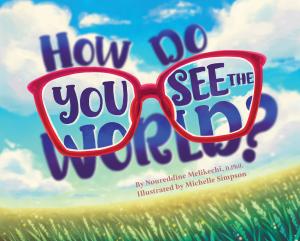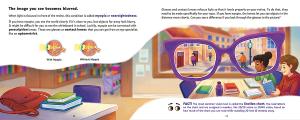
New Picture Book Helps Kids Understand the Anatomy and Science Behind Eyesight and Visual Impairments
Readers will find a delightfully simple explanation of how eyes work, including diverse eye conditions and helpful tools used to better navigate the world
With kid-friendly explanations of vision, light, color, and eye anatomy, How Do You See the World?, by Noureddine Melikechi, is the first children’s book to explore a variety of eye conditions and the helpful tools people use to better see the world around them. Perfect for anyone wanting to understand their eyes better, this book is great for both home and classroom use.
Eyes are complicated, and each little part has to work together to build a clear picture of what you see. Engaging and detailed science content covers the different parts of the eye, how light enters the eye and sends an image to the brain, how color works, and even ways people can perceive invisible light like ultraviolet and infrared.
"Melikechi takes a very complicated system and breaks it down in a very fun and engaging way that both adults and kids can appreciate," says Dana Spearin, an Optometric Physician. "If you want to gain understanding about the eyes and know what it is like to have certain eye conditions, this is the book for you!”
Written by an optical physicist, this informative picture book explores the various eye conditions kids may have or may learn about through their friends and relatives. What is it like to see the world through someone else's eyes? Find out through clear explanations of eye conditions such as amblyopia, astigmatism, color blindness, and glaucoma. Vibrant illustrations show how each of these conditions affects what a person sees, while offering examples of what tools can be used, like glasses or a guide dog, to navigate the world with a vision impairment.
Around 1 in 4 people across the globe are affected by a visual impairment. How Do You See the World? aims to teach kids ages 7-10 about the types of vision differences people may have, and how to understand and empathize with the different ways we all experience the world around us. Fun, diverse characters will help normalize all types of visual impairments and celebrate the tools and technology that help us see more clearly.
Optometrist Dr. Erica Meltzer writes, “How Do You See The World cultivates an appreciation for the gift of sight and fosters empathy for those who navigate the world with different visual perspectives. An essential addition to any library, and a must-read, even for the lucky ones with perfect vision!”
Noureddine Melikechi is a Professor of Physics at the University of Massachusetts Lowell, where he works on the interaction of light with various types of samples. He has studied why various objects have different colors. Noureddine has also used light to detect early signs of diseases such as cancers. A native of Algeria, Noureddine received his Diplôme d'Études Supérieures in Physics from the University of Sciences and Technology Houari Boumediene, Algeria, and his M.Sc. and D.Phil., both in Physics, from the University of Sussex. You can reach him at Noureddine.Melikechi@ScienceNaturally.com.
Michelle Simpson is a full-time freelance illustrator, focusing mainly on children's books. Some notable publications include I Can See You by Rosemarie Avrana Meyok, the Jordan and Max series by Suzanne Sutherland, and Talloqut: A Story from West Greenland by Paninnguaq Lind Jensen. She has also worked as a concept artist for kids’ cartoons such as Ollie! The Boy Who Became What He Ate (season two), Tee and Mo (season one), and Happy House of Frightenstein (season one). Michelle holds a BAA in illustration from Sheridan College in Ontario, and she lives on the Canadian side of Niagara Falls. See more of her work at MichelleScribbles.com.
Science Naturally is a small independent press in Washington, D.C. Their books are distributed to the trade by National Book Network [NBNbooks.com (domestic) and NBNi.co.uk (international)]. For more information about their publications, to arrange author interviews or graphics, for direct or bulk purchase pricing, or to request a review copy, please contact them. Cover images and sample content are available at ScienceNaturally.com.
How Do You See the World?
7-10 • 8 x 10” • 40 Pages
Hardback ($18.95): 978-1-958629-43-7
eBook ($13.99): 978-1-958629-44-4
Violet Antonick
Science, Naturally!
+1 202-465-4798
email us here
Visit us on social media:
Facebook
Twitter
LinkedIn
Instagram
EIN Presswire does not exercise editorial control over third-party content provided, uploaded, published, or distributed by users of EIN Presswire. We are a distributor, not a publisher, of 3rd party content. Such content may contain the views, opinions, statements, offers, and other material of the respective users, suppliers, participants, or authors.



